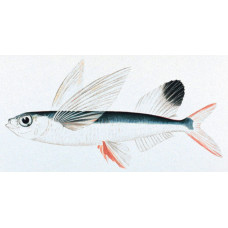Latin name
Parexocoetus brachypterus
Other names
Parexocoetus brachypterus
Identification
Stocky compared to other flying fishes. One of the distinguishing features is the blunt snout.
Like other members of this family, this species has the ability to leap out of the water and glide on hypertrophied fins to escape predators. It is considered a "two-winged" flying fish, meaning that only the pectoral fins are enlarged, as opposed to a "four-winged" flying fish, which has both pectoral and pelvic fins enlarged.
Features of fish fins
They have relatively small pectoral fins and a long dorsal fin compared to other flying fish. Dorsal spines (total): 0; Dorsal soft rays (total): 12-14; Anal spines: 0; Anal soft rays: 12-14.
Fish colouring
Body greenish blue behind, venter silvery white; dorsum black except for base and posterior rays, which are pale; pelvic fins grayish, other fins transparent.
Distribution
This species is distributed worldwide in coastal and subcoastal waters. It is found in the Atlantic, Pacific, and Indian Oceans. In the western Atlantic, it is found from the coast of northern Florida to Brazil, as well as the Gulf of Mexico and the Caribbean.
Habitat
Marine pelagic-neritic oceanodromic subtropical species. Occurs in coastal waters, rarely in the open ocean.
Size
The average length of P. brachypterus is 110-130 mm. The maximum length of males is 20.0 cm. Females of this species are usually slightly longer and heavier than males.
Behavior
During spawning, they gather in large numbers, in some cases groups can contain up to a million individuals. Individuals in such aggregations exhibit vigorous jumping, gliding, and swimming.
Food and feeding habits
Carnivores. They feed mainly on zooplankton. They have also been found feeding on fish scales and sargassum, and are considered a versatile species.
Reproduction
There is an unequal sex ratio in the groups, with males about three times more numerous than females. Small groups, usually consisting of 3-4 fish, have been observed during spawning. Such groups are thought to consist of a single female followed by several males. There are two spawning seasons during the year, September to January and March to August. Unlike other flying fish species, it is not known whether fertilized eggs must attach to debris. There are reports that the eggs of this species may be free-floating.
Fishing
In commercial fisheries, Sailfin Flying Fish are generally considered by-catch.
Relationship with a person
In Taiwan, locals eat them as food and also use them as bait. Flying fish roe is exported to Japan.
| Classification | |
| Phylum | Chordata |
| Class | Actinopterygii |
| Squad | Beloniformes |
| Family | Exocoetidae |
| Genus | Parexocoetus |
| Species | P. brachypterus |
| Features | |
| Conservation status | Not Evaluated |
| Habitat | Pelagic |
| Life span, years | No information |
| Maximum body weight, kg | No information |
| Maximum length, cm | 20 |
| Sailing speed, m/s | No information |
| Threat to people | Edible |
| Way of eating | Planktonophage |
Sailfin flying fish
Tags: sailfin flying fish

